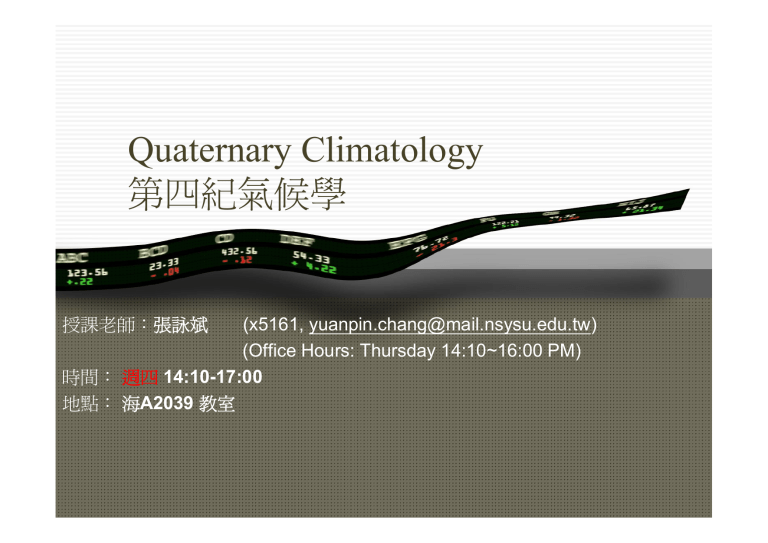Alphanumeric Ticker

Quaternary Climatology
第四紀氣候學
授課老師:張詠斌 (x5161, yuanpin.chang@mail.nsysu.edu.tw)
(Office Hours: Thursday 14:10~16:00 PM)
時間: 週四 14:10-17:00
地點: 海 A2039 教室
Schedule
• 2/20 Introduction of Quaternary
Climatology
• 2/27 Characteristics of
Quaternary Climate System
• 3/6 OR 3 Cruise
• 3/13 Quaternary Dating
Methods
• 3/20 Milankovitch Hypothesis
• 3/27 Solar Forcing and
Monsoon
• 4/3 Seminar
• 4/09 Proxies Used in
Paleoclimate Reconstruction
• 4/17 Tectonic- and Orbital- scale Climate Change
• 4/23 Break
• 4/30 Millennial-scale Climate
Change
• 5/7 Holocene Centennial and
Decadal Climatic Variability
• 5/14 Interannual Climate
Change
• 5/21 Sea-Level Change
• 5/29 Holiday
• 6/4 Paleo-atmospheres
• 6/11 Human Impact
• 6/19 Final Exam (3 pages paper report)
Episode 7
Tectonic- and Orbital-scale Climate
Change
Tectonic plates
A. Wegener (1914) proposed that continents have slowly moved across
Earth’s surface for hundreds and millions of years.
Earth’s structure
Continental crust: granite, 30-
70 kilometers thick, 2.7 g/cm 3 in density.
Ocean crust: basalt, 5-10 kilometers thick, 3.2 g/cm 3 in density.
Plate margins
Divergent (輻散) : mid-ocean ridge
Convergent ( 輻合) : trench, subduction
Transform fault ( 轉形斷層 )
Earth’s magnetic field
Magnetic stratigraphy
1. to roll back the recent motions of the seafloor.
2. To reconstruct the rate of seafloor spreading.
Age of the seafloor
The Polar Position Hypothesis
1. Ice sheets should appear on continents when they are located at polar or near-polar latitudes
2. No ice should appear anywhere on Earth if no continents exist anywhere near the poles
moraine scrape
Roche moutonnee
Pangaea
Model simulation
Temperature and monsoon
BLAG hypothesis (spreading rate hypothesis)
Spreading rate and CO
2 input
Negative feedback
Chemical weathering on land:
CaSiO
3
(Silicate rock) + CO
2
(Atmosphere) → CaCO
3
(plankton) +SiO
2
(plankton)
Meting and transformation in subduction zones:
CaCO
3
+ SiO
2
(ocean sediments) → CaSiO
3
(Silicate rock) + CO
2
(Atmosphere)
In this hypothesis, chemical weathering is a response driven by three factors:
Temperature , precipitation and vegetation .
The Uplift Weathering Hypothesis










